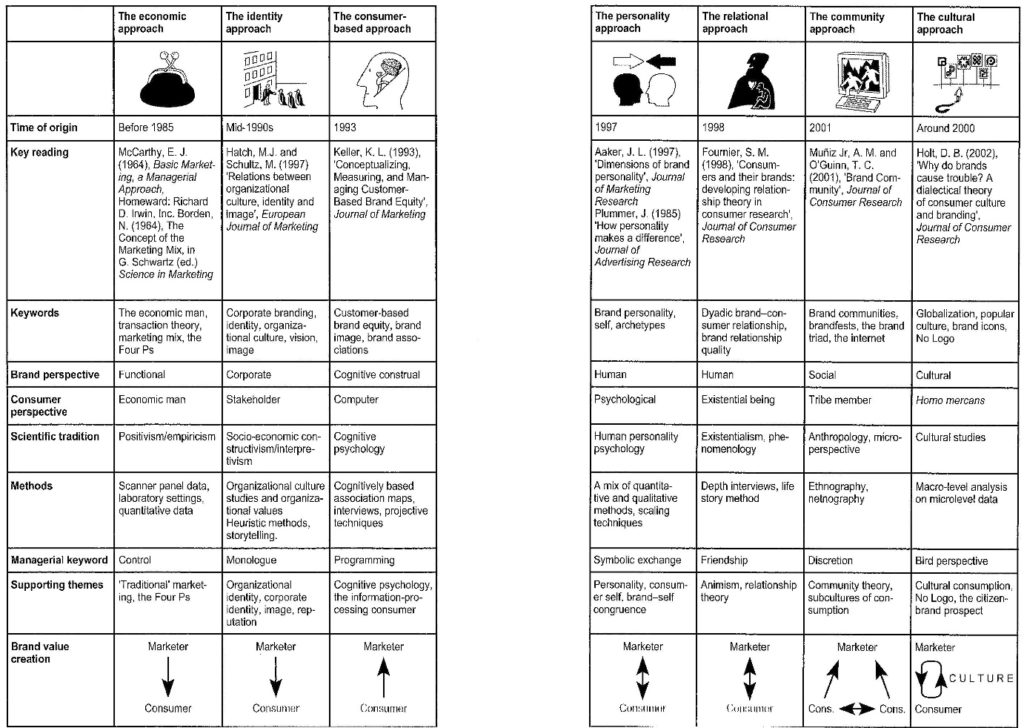On Wednesday, 18th of January 2017, we had Per-Töffner Knudsen’s lecture in HAMK Valkeakoski campus. Learning objective was to get introduced to the taxonomy of brand management 1985 – 2006, including seven approaches of branding that affect the companies supply chain management. Due the fact that customers are the companies’ most important stakeholders, it’s essential to know how to influence them. How can we influence the customers’ senses in order to convince them in supporting our product? In todays business environment, choosing the right methods are therefore essential for every branding and marketing process.
So, what are the seven schools of thoughts towards brand management?

- The economic approach: the brand as part of the traditional marketing mix
This model consists the concept of the traditional marketing mix parameters (4 P’s) that are fundamental in building a brand strategy. It is the basic, functional and economic marketing type, where companies are competing customers by price so they choose products they need or want by price. Social and economic points of view are always balancing.
- The identity approach: the brand as linked to corporate identity
A desired identity or self-image leads us to certain shops. Companies as main brand value creators use for example storytelling in marketing. Furthermore, with whom we speak with has an influence on our decisions. Same kind of people affects to the same kind of people – positive reference.
- The consumer-based approach: the brand as linked to consumer associations
What do our customers want? Measuring and observing customers of how they actually act in order to offer an environment and products for their needs. Companies are aware of various types of customers so they can offer just the right kind of services to the target customer segment. Observing methods can be for example interviews and experiments.
- The personality approach: the brand as a human-like character
This model draws on product placements in movies, music videos and sport events etc. to convince fans or customers to buy the same products. Sponsoring is the major part of this approach. Customers can use same brands as for example James Bond by buying clothes or accessories their favorite character use in a film, and therefore get a feeling of being James Bond. Branding through personality if effective because people always want to give some vision about themselves to others, and the company can support for example certain lifestyle or values.
- The relational approach: the brand as a viable relationship partner
Companies use dyadic relationship between a customer and a brand to create feeling of companionship. Companies often hark back on bonus cards, direct emails and customer events for their regular customers. With these activities, companies are seeking in gathering relevant information about their customers’ behaviors as well. Therefore, companies can highly focus on their customer’s specific interests. Moreover, Customers get a feeling of being respected and one to one communication gives the consumers the feeling that they are personally connected as a part of the company.
- The community approach: the brand as the pivotal point of social interaction
People usually want to be a part of some community or social environment. What do you think about how advertising agency or a secretary in a big financial bank should wear? Can they dress up in the same way? Or are they expected to dress up in an appropriate way? The community approach uses ethnography and community theories to clarify customers.
- The cultural approach: the brand as part of the broader cultural fabric
This approach contains the aspect of cultural consumptions. What have we learned to wear? Can we effect the new generation of consumers? Brands such as H&M or ZARA have clothes for kids and adults. So if we go to that shop with our parents, how does it affect us? When we grow up, do we go to the H&M because we are used to do so? This approach draws on the bird perspective in order to see and foretell what might be coming in the future, and pays attention on how the world is changing and how for example the trends influence customers. Some of the keywords are popular culture as well as “No Logo”.
Conclusion
Sometimes, one branding approach is not enough. Nowadays, a mix of several branding models implication can be found within a company. There is no “the” right approach or model. However, all these presented approaches indicate a clear trend. There is an important shift away from the traditional one way sending of brand communication (e.g. the economic and identity approaches) to a strong focus on addressing the contextual and cultural influences on the brand (e.g. the cultural approach). In order to gain a global understanding of brand management, companies must first understand the basic thoughts and ideas behind all these models. Furthermore, they have to realize and accept that their customers own the brand, and therefore affect the brand value creation.
Elina Kataja, Jenni Rantala, Thanh Nguyen





Discussion3 Comments
According to your article,
I got some question! Does it reliable and budget friendly to all?
Some people does not care about brand,
is there any alternative of these sports products?
How long lasting Best sports products ? Hope you response on these point.
Waiting for your response.
More over good job and keep it up.
Very much Informative. I love your blogs and already a follower of it. I think that when it comes to Branding so it’s very necessary for new business to have a Branding that perfectly resembles their business xand a complete Branding solution to connect with its consumers.
Amazing article! Thank you for sharing💛
Check out the Future of Branding Week Live, where creative director of Diageo will talk about ⚡️How teams can work together to build stronger brands.⚡️https://bit.ly/2Yyeuwe